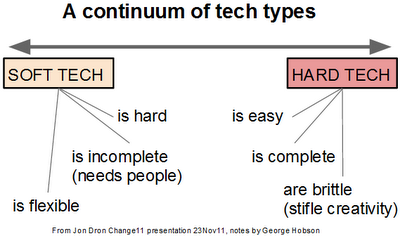Quite a lot of fantastic ideas popped up, relating to constraints and creativity, as shared by Jenny.
I think the ChangeMOOC type of MOOC – if it wants the creation of artifacts – needs to look to MOOCs like ds106 and see what can be learned from them and I don’t think that the ‘constraints drives creativity argument stands up’. So where are the ChangeMOOC artifacts and what are the reasons for participants’ reluctance to produce them? Including me ☺
She has also posted here relating to getting the balance right between soft and hard technologies.
I will respond to her questions in another post later, but now I have been thinking about “Repurposing ( creation – ‘we want you to create something of your own’)”
What would “we” want to create of our own? If it is a wiki development, then some participants have already set up their own, and are working with others. There are wikis built here (here (with pageflake)), developed for classes, and wikis in particular areas. There are participants who created blog posts, and or the production of videos and podcasts (as in DS106), slideshare, flickr photos, or concept maps.
Stephen in his post on Engagement and Motivation says:
I find that many traditional measures – such as counting attendance or page views – do not account for the sort of engagement we’d like to see, and is demonstrated for example in ds106. In addition, provision of the ability to determine one’s own educational path or even to satisfy one’s other motivations, may be necessary, but are not sufficient, to support motivation in MOOCs. In the end I consider the example of how motivation is created in gaming environments, and wonder whether MOOCs need challenges and the possibility of failure in order to stimulate student engagement.
I like Stephen’s mention about “satisfying one’s other motivations, may be necessary, but are not sufficient, to support motivation in MOOCs”.
First, motivation to me could be very different from that motivation for others, and thus could be idiosyncratic in nature. What makes it fascinating is that both intrinsic and extrinsic motivation are essential factors towards success in MOOC. There are however, network dynamics which accounted for such motivation to create artifacts, or posting and commenting on each others, as observed in past MOOCs.
Second, encouraging creativity is essential in Online Courses. In this Encouraging Creativity in Online Courses by Stephenie A, Clemons: Giving students opportunities to be creative means allowing them to find and solve problems and communicate ideas in “novel” and “appropriate” ways (Starko, 1995).
As summarised in this post by edtech, a balance between hard and soft technology is necessary to create the learning environment for learning in MOOC.
I found Jenny’s claim resonating: Constraints are not enabling creativity, but definitely stifling it. Yes, I have similar experiences, due mainly to the power constraints. An example was the use of ConnectivismEducationLearning Ning. We had no choice but to leave it as we couldn’t afford to pay the fees. Haven’t we got the creativity to develop our network community?
How to respond to those issues and challenges relating to creativity?
“To appease the masses, we could water-down the extremity of our ideas to fit into the creative categories of ideas that just support incremental forward progress, to maintain more of the status quo. Society would probably be more accepting of less radical, mediocre ideas versus ones that shake up the current ideology. So in a sense, to be a “good, peaceable member of society”, one that teachers love and employers want, the best we should strive for is to reach the highest level of mediocrity possible.”
How to balance soft and hard technology? That is still a challenging problem in networked learning. We still need people to “temper” the technology, and educators to fulfill the roles of ensuring and supporting an appropriate balancing act when navigating the networks and teaching and learning with the learners in such technology platforms or media. What sort of examples do we have in such balancing acts?

Eh did you mention http://change11.info/index.php/ the wiki of change11?
You could even write some words in it.
Pingback: #Change11 Creativity, Constraints and Design | UkrEL11 | Scoop.it
Thanks Jaap, Thanks for your visit. Yes, I mentioned it here: If it is a wiki development, then some participants have already set up their own, and are working with others.
I will need to reflect deeply before I could contribute there. That is the not too soft, but not too hard of the pedagogy 🙂
John
Pingback: Asking Why Instead of How (#Change11) | Collaborative Understandings
Pingback: GT MOOC Week 12: Advanced Learning Strategies with Clark Aldrich | The Georgia Tech MOOC
Pingback: Which Learning Theory would be most appropriate for our Education System? Instructivism, Constructivism, or Connectivism | Learner Weblog